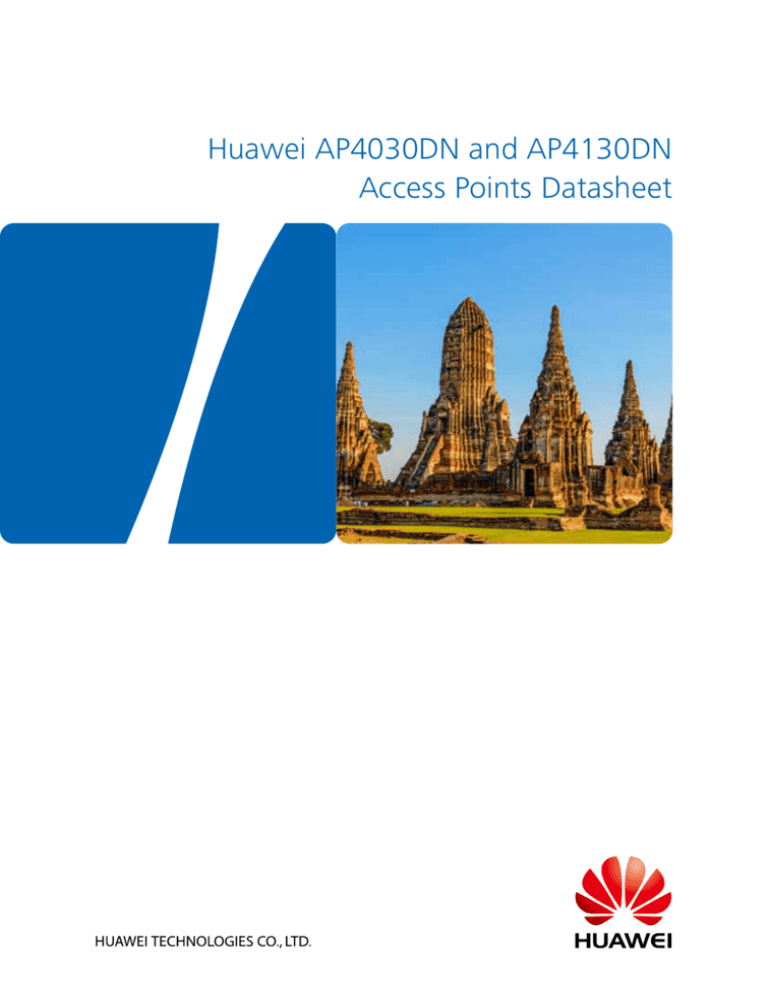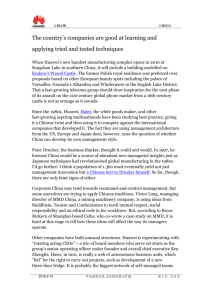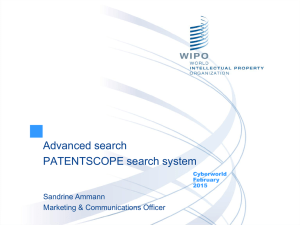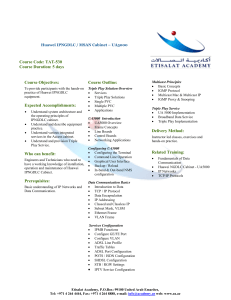
Huawei AP4030DN and AP4130DN
Access Points Datasheet
Huawei AP4030DN and AP4130DN Access Points Datasheet
Huawei AP4030DN and AP4130DN are 802.11ac access points (APs) that
work in Fat or Fit mode on Wireless Local Area Networks (WLANs). They
support 2x2 MIMO, provide comprehensive service support capabilities,
and possess the following features: proven reliability, high security, simple
network deployment, automatic AC discovery and configuration, and realtime management and maintenance. The AP4030DN and AP4130DN
comply with IEEE 802.11ac and provide gigabit access for wireless users,
ensuring a superb experience for wireless network users.
Product Features
•
Recommended for use in locations with a simple structure, a small
area, or high user density, such as small and medium enterprises, smart
buildings, hospitals, and large shopping malls
Huawei AP4030DN Access Point
Built-in antennas
2.4 GHz and 5 GHz frequency bands
IEEE 802.11a/b/g/n/ac
Huawei AP4130DN Access Point
External antennas
2.4 GHz and 5 GHz frequency bands
IEEE 802.11a/b/g/n/ac
Huawei AP4030DN and AP4130DN features:
• High-speed and reliable wireless access
services: uses the latest 802.11ac chip for
better performance and wider coverage.
• Integrated Multiple-Input MultipleOutput (MIMO) antennas: implements
omnidirectional coverage without
coverage holes, and provides a rate of up
to 1.167 Gbit/s.
• Comprehensive user access control:
implements user access control according
to user group policies with support for up
to 256 users.
• High level of security: supports multiple
authentication and encryption methods,
as well as rogue AP detection.
• Flexible networking and strong
environmental adaptability: applies to
access, WDS, and Mesh networking
scenarios.
• Easy to manage and maintain: supports
Plug-and-Play (PnP)
1
HUAWEI WLAN Products Portfolio
•
2 x 2 MIMO technology (two spatial streams): 1.167 Gbit/s for the
device
•
Spectrum analysis for detecting and analyzing surrounding interference
sources
•
Locating service
•
WIDS/WIPS for monitoring and countering rogue terminals and APs
•
High Density Boost with unparalleled multi-user concurrent
performance
•
Beamforming
•
IPv4/IPv6 dual stack
•
PoE power supply in compliance with IEEE 802.3af/at, simplifying AP
installation
•
External antennas on the AP4130DN with high flexibility in antenna
gain configuration and device deployment locations
Scalability
When coupled with Access Controllers (ACs) and Network Management
Systems (NMSs), Huawei 802.11ac APs can implement real-time
monitoring, intelligent Radio Frequency (RF) management, spectrum
analysis, wireless positioning, load balancing, roaming, security policy
control, wired and wireless convergence, as well as Bring Your Own Device
(BYOD) network security control and smart access management. The AC +
Fit AP architecture is highly scalable and supports centralized management
of multiple Fit APs on a single AC. Software upgrade technologies allow
users to seamlessly add and upgrade APs without incurring additional
administrative or equipment costs.
AP Networking
Huawei AP4030DN and AP4130DN can work in AP, WDS, or Mesh mode.
The following figures show typical AP4030DN and AP4130DN networking.
Fat AP networking
Internet
AP4030
AP4130DN
AP4030
AP4130DN
When working as a Fat AP, the AP4030DN and AP4130DN provide user authentication and access, data
security, service data forwarding, Quality of Service (QoS), and other functions, without an AC.
Fit AP networking
Branch router
Internet
Network management center
+
Authentication and accounting server
(Optional)
AC6605/AC6005
Aggregation switch
Aggregation layer
PoE switch
Access layer
100 m
PoE network
cable
PoE network cable
AP4130DN/AP4030
AP4130DN/AP4030
AP4130DN/AP4030
1GE network cable
10GE optical fiber
Wi-Fi data flow
CAPWAP tunnel management
Wi-Fi terminal
5G WDS/Mesh
When working as a Fit AP, the AP4030DN and AP4130DN provide bridging and data forwarding
functions. An AC is required for user access, AP management, authentication, routing, security, and QoS.
In WDS mode, the AP supports Point-to-Point (P2P) and Point-to-Multi-Point (P2MP) networking. With 5
GHz and 2.4 GHz frequency bands, the AP4030DN and AP4130DN provide wireless bridging and access
functions.
Mesh Points (MPs) interconnect in a Mesh topology to form a self-configuring and self-healing Wireless
Mesh Network (WMN) backbone, with Mesh Portal Points (MPPs) providing a connection to the Internet.
Stations can connect to the WMN network through Mesh Access Points (MAPs). Dedicated Mesh routing
protocols provide better transmission quality and ensure high bandwidth and highly stable Internet
connections.
HUAWEI WLAN Products Portfolio
2
Basic Specifications
Item
Physical
specifications
Power
specifications
Environmental
specifications
Description
Dimensions (W x D x H)
180 mm x 180 mm x 39.5 mm
Weight
0.4 kg
Ethernet port
RJ45 x 1
System memory
• 256 MB DDR2
• 32 MB flash memory
Power input
• 12 V DC ± 10%
• PoE power supply: -48 V DC (in compliance with IEEE
802.3af/at)
Maximum power
consumption
10.2 W
NOTE: The actual maximum power consumption
depends on local laws and regulations.
Operating temperature
–10OC to 50OC
Storage temperature
–40OC to 70OC
Operating humidity
5% to 95% (non-condensing)
Dustproof and
waterproof grade
IP41
Altitude
–60 m to 5,000 m
Atmospheric pressure
70 kPa to 106 kPa
Radio Specifications
Item
Description
Antenna type
AP4030DN: built-in antennas
AP4130DN: external dual-band combined antennas
Antenna gain
• AP4030DN: 4 dBi (2.4 GHz); 6 dBi (5 GHz)
• AP4130DN: 2.5 dBi (2.4 GHz); 4 dBi (5 GHz)
Maximum
number of users
256
Maximum
transmit power
23 dBm
NOTE: The actual maximum transmit power depends on local laws and regulations.
Power increment
1 dBm
2.4 GHz 802.11b (CCK): -101 dBm @ 1 Mb/s; -89 dBm @ 11 Mb/s
2.4 GHz 802.11g (non-HT20): -95 dBm @ 6 Mb/s; -79dBm @ 54 Mb/s
2.4 GHz 802.11n (HT20): -93 dBm @ MCS0; -75dBm @ MCS7
Receiver
sensitivity
2.4 GHz 802.11n(HT40): -90 dBm @ MCS0; -73dBm @ MCS7
5 GHz 802.11a (non-HT20): -95 dBm @ 6 Mb/s; -78dBm @ 54 Mb/s
5 GHz 802.11n (HT20): 95 dBm @ MCS0; -75 dBm @ MCS7
5 GHz 802.11n (HT40): -92 dBm @ MCS0; -73dBm @ MCS7
3
HUAWEI WLAN Products Portfolio
Item
Description
5 GHz 802.11ac (VTH20): -95dBm @ MCS0NSS1; -72 dBm @ MCS8NSS1
Receiver
sensitivity
5 GHz 802.11ac (VTH40): -92 dBm @ MCS0NSS1; -67 dBm @ MCS9NSS1
5 GHz 802.11ac (VTH80): -87 dBm @ MCS0NSS1; -62 dBm @ MCS9NSS1
Product Features
WLAN
features
Compliance with IEEE 802.11a/b/g/n/ac
Maximum rate: 1.167 Gbit/s
Maximum Ratio Combining (MRC)
Cyclic Shift Diversity (CSD)
Maximum Likelihood Detection (MLD)
Data unit aggregation, including A-MPDU (Tx/Rx) and A-MSDU (Rx only)
802.11 Dynamic Frequency Selection (DFS)
Short Guard Interval (GI) at 20-MHz, 40-MHz, and 80-MHz modes
Priority mapping and packet scheduling according to a Wi-Fi Multimedia (WMM)
profile for priority-based data processing and forwarding
Automatic and manual rate adjustment (the rate is adjusted automatically by default)
WLAN channel management and channel rate adjustment
Automatic channel scanning and interference avoidance
Service Set Identifier (SSID) hiding, support for SSIDs in Chinese
Signal Sustain Technology (SST)
Unscheduled Automatic Power Save Delivery (U-APSD)
Control and Provisioning of Wireless Access Points (CAPWAP)
Automatic access in Fit AP mode
WDS in Fit AP mode
Mesh in Fit AP mode
Dual-MPP Mesh networking in Fit AP mode
Hotspot2.0 in Fit AP mode
802.11k and 802.11v smart roaming in Fit AP mode
Network
features
Compliance with IEEE 802.3u
Auto-negotiation of the rate and duplex mode and automatic switchover between
the Media Dependent Interface (MDI) and Media Dependent Interface Crossover
(MDI-X)
SSID-based VLAN assignment
4094 VLAN IDs (1-4094) and a maximum of 16 Virtual APs (VAPs) for each radio
AP control channel in tagged and untagged mixed mode
Network
features
DHCP client (IP addresses are obtained through DHCP)
Tunnel forwarding and direct forwarding
STA isolation in the same VLAN
Multicast Domain Name Service (mDNS) gateway protocol: supports AirPlay and
AirPrint service sharing between users of different VLANs
Access Control Lists (ACLs)
Link Layer Discovery Protocol (LLDP)
Service holding upon CAPWAP link disconnection in direct forwarding in Fit AP mode
Unified authentication on the AC in Fit AP mode
AC dual-link backup in Fit AP mode
Soft GRE
HUAWEI WLAN Products Portfolio
4
QoS features
Priority mapping and packet scheduling according to a WMM profile for prioritybased data processing and forwarding
WMM parameter management for each radio
WMM power saving
Priority mapping for upstream packets and flow-based mapping for downstream
packets
Queue mapping and scheduling
User-based bandwidth limiting
Adaptive bandwidth management (the system dynamically adjusts bandwidth
allocation based on the user quantity and environment to improve user experience)
Fair airtime scheduling
Security
features
Open system authentication
WEP authentication/encryption
WPA/WPA2-PSK authentication and encryption
WPA/WPA2-802.1x authentication and encryption
WAPI authentication and encryption
WIDS including rogue AP and STA detection, attack detection, STA/AP blacklist and
whitelist
802.11w Protected Management Frames (PMFs)
Maintenance
features
Unified management and maintenance on the AC in Fit AP mode
Plug-and-Play (PnP) in Fit AP mode: automatic access and configuration loading in Fit
AP mode
WDS zero-configuration deployment in Fit AP mode
WMN zero-configuration deployment in Fit AP mode
Automatic batch upgrades
Local AP management using Telnet
Real-time configuration monitoring and rapid fault location using the NMS
System status alarm
BYOD
Identifies the device type according to the Organizationally Unique Identifier (OUI) in
the MAC address.
Identifies the device type according to the User Agent (UA) information in an HTTP
packet.
Identifies the device type according to DHCP options.
The RADIUS server delivers packet forwarding, security, and QoS policies according to
the device type carried in the RADIUS authentication and accounting packets.
Locating
service
Locates tags manufactured by AeroScout or Ekahau.
Locates Wi-Fi terminals.
Spectrum
analysis
Identifies interference sources such as baby monitors, Bluetooth devices, digital
cordless phones (at 2.4 GHz frequency band only), wireless audio transmitters (at both
the 2.4 GHz and 5 GHz frequency bands), wireless game controllers, and microwave
ovens.
Works with the Huawei eSight system to locate and perform spectrum analysis on
interference sources.
Standards Compliance
5
Safety
standards
UL 60950–1
IEC 60950–1
EN 60950–1
GB 4943
Radio
standards
ETSI EN 300 328
ETSI EN 301 893
RSS-210
AS/NZS 4268
HUAWEI WLAN Products Portfolio
EMC
standards
EN 301 489–1
EN 301 489–17
ETSI EN 60601-1-2
ICES-003
YD/T 1312.2-2004
ITU k.21
GB 9254
IEEE 802.11a/b/g
IEEE 802.11n
IEEE standards IEEE 802.11ac
IEEE 802.11h
IEEE 802.11d
Security
standards
GB 17625.1
EN 55022
EN 55024
CISPR 22
CISPR 24
IEC61000-4-6
IEC61000-4-2
IEEE 802.11e
IEEE 802.11k
IEEE 802.11u
IEEE 802.11v
IEEE 802.11w
802.11i, Wi-Fi Protected Access 2(WPA2), WPA
802.1X
Advanced Encryption Standards(AES), Temporal Key Integrity Protocol(TKIP)
EAP Type(s)
ETSI 300 019-2-1
Environmental
ETSI 300 019-2-2
standards
ETSI 300 019-2-3
EMF
CENELEC EN 62311
CENELEC EN 50385
RSS-102
RoHS
Directive 2002/95/EC & 2011/65/EU
Reach
Regulation 1907/2006/EC
WEEE
Directive 2002/96/EC & 2012/19/EU
ETSI 300 019-1-1
ETSI 300 019-1-2
ETSI 300 019-1-3
Professional Service and Support
Huawei WLAN planning tools deliver expert network design and optimization services using the most
professional simulation platform in the industry. Backed by fifteen years of continuous investment in
wireless technologies, extensive network planning and optimization experience, as well as rich expert
resources, Huawei helps customers:
•
Design, deploy, and operate a high-performance network that is reliable and secure.
•
Maximize return on investment and reduce operating expenses.
More Information
For more information, please visit http://e.huawei.com or contact your local Huawei office.
Enterprise Services
Product Overview
Marketing Documentation
HUAWEI WLAN Products Portfolio
6
Copyright © Huawei Technologies Co., Ltd. 2015. All rights reserved.
No part of this document may be reproduced or transmitted in any form or by any means without prior written consent of Huawei
Technologies Co., Ltd.
Trademark Notice
, HUAWEI, and
are trademarks or registered trademarks of Huawei Technologies Co., Ltd.
Other trademarks, product, service and company names mentioned are the property of their respective owners.
General Disclaimer
The information in this document may contain predictive statements including,
without limitation, statements regarding the future financial and operating results,
future product portfolio, new technology, etc. There are a number of factors that
could cause actual results and developments to differ materially from those
expressed or implied in the predictive statements. Therefore, such information is
provided for reference purpose only and constitutes neither an offer nor an
acceptance. Huawei may change the information at any time without notice.







